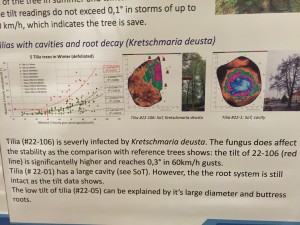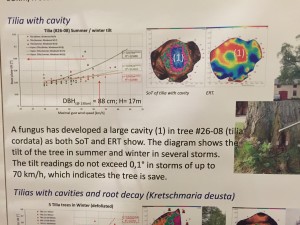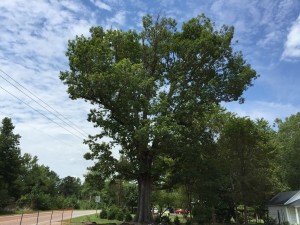Always new things learned at ISA conferences. First 2 pics show research indicating that fungal activity and interior decay can strengthen tree stability. Drill-and-kill assessments that condemn hollow trees ass-u-
 me the opposite, with no scientific basis.
me the opposite, with no scientific basis.
5 thoughts on “ISA Conference 2015”
Comments are closed.

theres a big difference between ‘can’ increase strength and does/will increase strength. i would agree that minimal hollowing has a negligable effect on structure. i also believe experiments can be set up to prove any point you want, much like the ocean liner that can go anywhere if its got enough fuel.
A well-branched canopy can reduce (dynamic) wind loads by resonance damping, as our research had shown. So may be the tilia shown in the images is stable IN SPITE of the trunk decay. This is why pulling tests can be helpful to asses at least a tree’s resistance against a static load from the main wind direction of its stand.
The experiments show ‘did’; more than ‘can’ but of course less than ‘will’, which is harder to say.
The design of this experiment seemed valid to me. It’s not the last word on the topic of course.
Yes a well branched canopy is key for stability. Pruning can (and most often does, and hopefully will) improve stability.
Hi Guy,
I’m interested to read more, is there a full paper or further slides available to download somewhere?
Cheers
Detective Dendro!
Thank you for your postings! Indeed, as the former Tomograph Technician for Tree Solutions Inc. (Seattle); a graduate student at the University of Washington School of Environmental and (Urban[e]) Forest Sciences; and a fortunate arborist for the Shigo, Trees, and Associates family; it has been my experience that there can be corresponding reaction wood around a cavity to compensate for the vacancy of interior structure. Sound wave velocity analysis is exceedingly helpful in conceptualizing what cannot be probed in a trunk/roots. I tend to follow the Shigovian preference to not damage the tree beyond the latest increment of annual growth. Dendropedically speaking, this involves be more like a sapsucker than a woodpecker. However, I am yet to find and utilize a fully functional Shigometer.
Referencing the initial comment, I’d say that the nautical metaphor could be used to distinguish that the function, form, aesthetics, and enjoyment of Shakleton’s Endurance differed from those of the TItantic mostly on the basis of ship materials, design, and guidance. Not to minimize historic tragedy, though I have been rather dismayed to learn about how many well-compartmented and compartmentalizing trees have been “tested” right through the 4th Wall of their “hull”. Huzzah! A cavity was found using tools and direct evidence! Now what?
Thus, it’s somebody’s job to wonder how a fungal pathogen feels about the respective “Chunnel-sized” hole that the Resistograph has left in the wood tissue. Perhaps it is time to consider the elusive 5th Wall of Compartmentation, when the tree sends epicormic roots into decayed materials on or inside itself and others…
Speaking of Wonder, I recommend checking out the full-scale, Middle Fork (Western hemlock) sculpture that’s going to be part of a larger exhibit at the Smithsonian (Renwick Gallery) in November. While the pieces are in transit from WA to DC, there’s more information at:
http://www.johngrade.com/#/projectwithdescription/MIDDLE%20FORK/true
and Guy, if you can make it up to Washington the city, I’ll gladly offer lunch in recompense for that which you provided (free to me) after ISA Milwaukee.
Enjoy your trip to Bend!
NWD